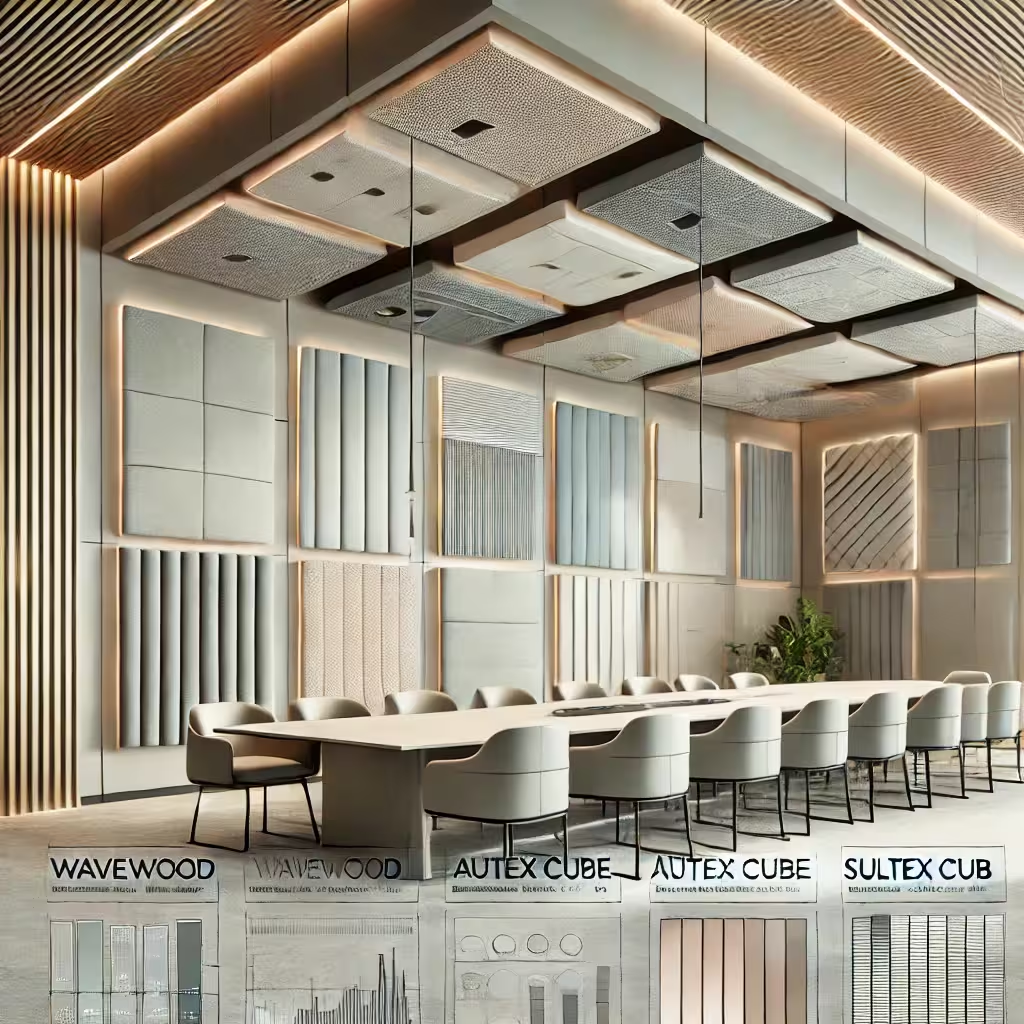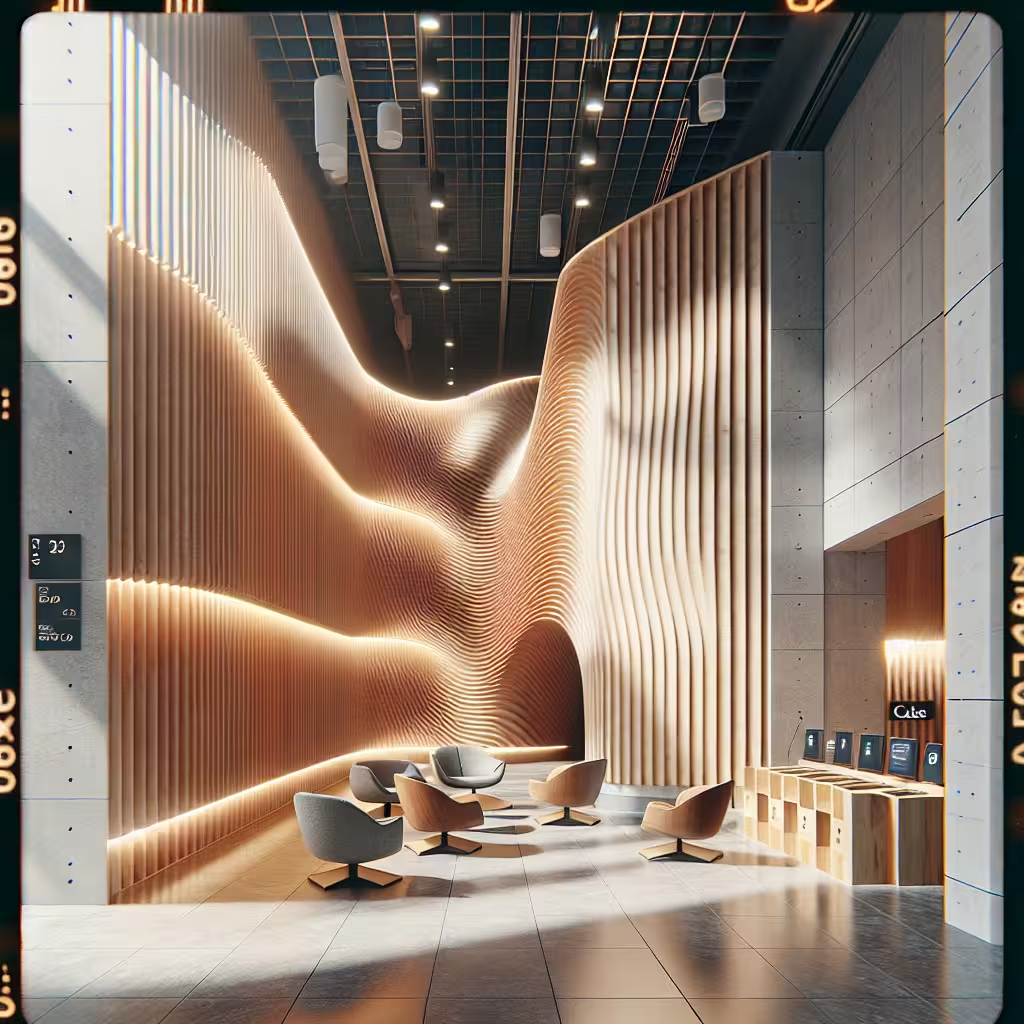In our quest for comfort and well-being, we often overlook the impact of sound on our daily lives. Designer acoustic panels offer more than just noise reduction; they satisfy our fundamental needs for protection, understanding, and identity. By creating harmonious environments, these panels contribute to our sense of belonging and self-expression. This guide explores how luxury acoustic solutions can transform intermediate spaces, enhancing both our auditory experience and our connection to our surroundings.
Reader Disclosure
Jump to:
Understanding Acoustic Panels for Intermediate Spaces
Intermediate spaces, such as hallways, lobbies, and open-plan offices, present unique acoustic challenges. These areas often serve as transitional zones between different environments, making sound management crucial for maintaining a sense of continuity and comfort.
The Science of Sound Absorption
Acoustic panels work by absorbing sound waves, reducing echo and reverberation. The effectiveness of a panel is measured by its Noise Reduction Coefficient (NRC), which ranges from 0 (no absorption) to 1 (perfect absorption).
Key Factors in Choosing Acoustic Panels
- Absorption Coefficient: Look for panels with high NRC ratings for optimal performance.
- Aesthetics: Designer panels should complement the space’s visual appeal.
- Durability: Consider materials that withstand wear in high-traffic areas.
- Sustainability: Eco-friendly options align with modern design principles.
Top 3 Luxury Acoustic Panel Products for Intermediate Spaces
1. Vicoustic Wavewood Ultra Lite
The Vicoustic Wavewood Ultra Lite panels offer a perfect blend of form and function. Their undulating surface not only provides excellent sound absorption but also creates a visually striking feature in any space.
Key Features:
- NRC: 0.85
- Material: Sustainable wood and acoustic foam
- Dimensions: 60 x 60 cm
- Thickness: 3.6 cm
Why It’s Great for Intermediate Spaces:
The Wavewood Ultra Lite panels satisfy our need for protection by creating a serene acoustic environment. Their natural wood finish adds warmth and character to transitional areas, fostering a sense of connection to nature and enhancing our overall well-being.
2. Autex Cube
Autex Cube panels are versatile and highly customizable, making them ideal for creating unique acoustic solutions in intermediate spaces.
Key Features:
- NRC: 0.80
- Material: 100% polyester fiber
- Dimensions: Custom sizes available
- Thickness: 12-24 mm
Why It’s Great for Intermediate Spaces:
These panels cater to our need for identity and creativity. The wide range of colors and patterns allows for personalized designs that reflect the character of the space and its occupants. The ability to create custom shapes and installations fosters a sense of participation in the design process.
3. SilentSpace Panels
SilentSpace Panels offer a minimalist approach to acoustic treatment, perfect for modern intermediate spaces that require a subtle touch.
Key Features:
- NRC: 0.78
- Material: Recycled polyester
- Dimensions: Various sizes available
- Thickness: 25-50 mm
Why It’s Great for Intermediate Spaces:
These panels address our need for understanding by creating clear, intelligible acoustic environments. Their sleek design promotes a sense of order and calm, contributing to improved focus and communication in transitional areas. Check out our Buyer’s Guide Topic Page.

Comparative Analysis
To help you make an informed decision, let’s compare these luxury acoustic panels based on key factors:
| Product | NRC | Aesthetics | Customization | Sustainability |
|---|---|---|---|---|
| Vicoustic Wavewood Ultra Lite | 0.85 | High | Medium | High |
| Autex Cube | 0.80 | High | Very High | High |
| SilentSpace Panels | 0.78 | Medium | High | Very High |
Installation and Maintenance
Proper installation and maintenance are crucial for maximizing the performance and longevity of acoustic panels. Here are some key considerations:
- Professional Installation: While some panels can be DIY-installed, professional installation ensures optimal placement and performance.
- Regular Cleaning: Dust and vacuum panels gently to maintain their appearance and effectiveness.
- Moisture Control: Avoid installing panels in areas prone to high humidity or direct water exposure.
- Periodic Inspection: Check for any damage or wear, especially in high-traffic areas.
The Psychology of Sound in Intermediate Spaces
Understanding the psychological impact of sound in transitional areas is crucial for creating harmonious environments. Well-managed acoustics can:
- Reduce stress and anxiety
- Improve cognitive function and concentration
- Enhance social interaction and communication
- Create a sense of privacy and personal space
By addressing these psychological aspects, designer acoustic panels contribute to our fundamental needs for protection, understanding, and participation in our surroundings.
Sustainability and Eco-Friendly Options
As environmental consciousness grows, so does the demand for sustainable acoustic solutions. Many manufacturers now offer eco-friendly options that don’t compromise on performance or aesthetics:
- Recycled materials (e.g., PET bottles)
- Biodegradable fibers
- Low-VOC adhesives and finishes
- Cradle-to-cradle certified products
Choosing sustainable acoustic panels not only benefits the environment but also contributes to a healthier indoor space, aligning with our need for a balanced and responsible approach to design.
Integrating Acoustic Panels with Smart Home Technology
The future of acoustic management lies in its integration with smart home systems. Imagine panels that can:
- Adjust their absorption properties based on room occupancy
- Change color or pattern to match the mood or time of day
- Incorporate ambient lighting or air purification features
These innovations not only enhance the functionality of acoustic panels but also satisfy our need for creation and adaptability in our living spaces.
Cost Considerations and Return on Investment
While luxury acoustic panels may require a significant initial investment, it’s important to consider the long-term benefits:
- Improved productivity in work environments
- Enhanced property value for residential and commercial spaces
- Reduced energy costs due to improved insulation properties
Case Studies: Successful Implementations
To illustrate the real-world impact of designer acoustic panels in intermediate spaces, let’s examine two case studies:
- Tech Company Headquarters: A Silicon Valley firm installed Autex Cube panels in their open-plan office, resulting in a 30% reduction in noise complaints and a 15% increase in reported employee satisfaction.
- Luxury Hotel Lobby: The integration of Vicoustic Wavewood Ultra Lite panels in a high-end hotel’s lobby led to a 40% improvement in guest survey scores related to ambiance and comfort.
- These examples demonstrate how thoughtful acoustic design can significantly enhance the user experience in transitional spaces.

People Also Ask
How many acoustic panels do I need for my space?
The number of panels depends on room size, existing acoustics, and desired effect. A general rule is to cover 20-30% of wall surface area for optimal results.
Can acoustic panels be painted or customized?
Many panels can be customized with fabric wraps or printed designs. Some can be painted, but this may affect their acoustic properties.
Do acoustic panels block sound from other rooms?
Acoustic panels primarily absorb sound within a room. For sound blocking between spaces, consider soundproofing solutions like mass-loaded vinyl.
Conclusion
Designer acoustic panels offer a sophisticated solution for managing sound in intermediate spaces, addressing our fundamental needs for comfort, identity, and well-being. By carefully selecting and implementing these luxury products, we can create harmonious environments that not only sound better but also contribute to our overall quality of life. As we continue to recognize the importance of acoustic design, these panels will undoubtedly play a crucial role in shaping the spaces we inhabit and transition through.
Show & Tell
We’d love to hear your thoughts about these ideas! Simply click the link to head over to your favorite platform and add your comments about this post there. We’d like to know about your insights, questions, or just saying hi.
Disclosure
Our content is reader-supported. This means if you click on some of our links, then we may earn a commission. Commissions do not affect our editor’s opinions or evaluations. Learn more about our editorial process.

About the Editorial Staff
The Curvspace editorial team comprises a diverse group of experts on intermediate and threshold spaces in homes and workplaces. Architects and interior designers, civil engineers and artists, environmental and behavioral psychologists, sociologists and anthropologists. All collaborate to create helpful content, that explores the full potential of these often-overlooked areas to enhance our daily lives.


